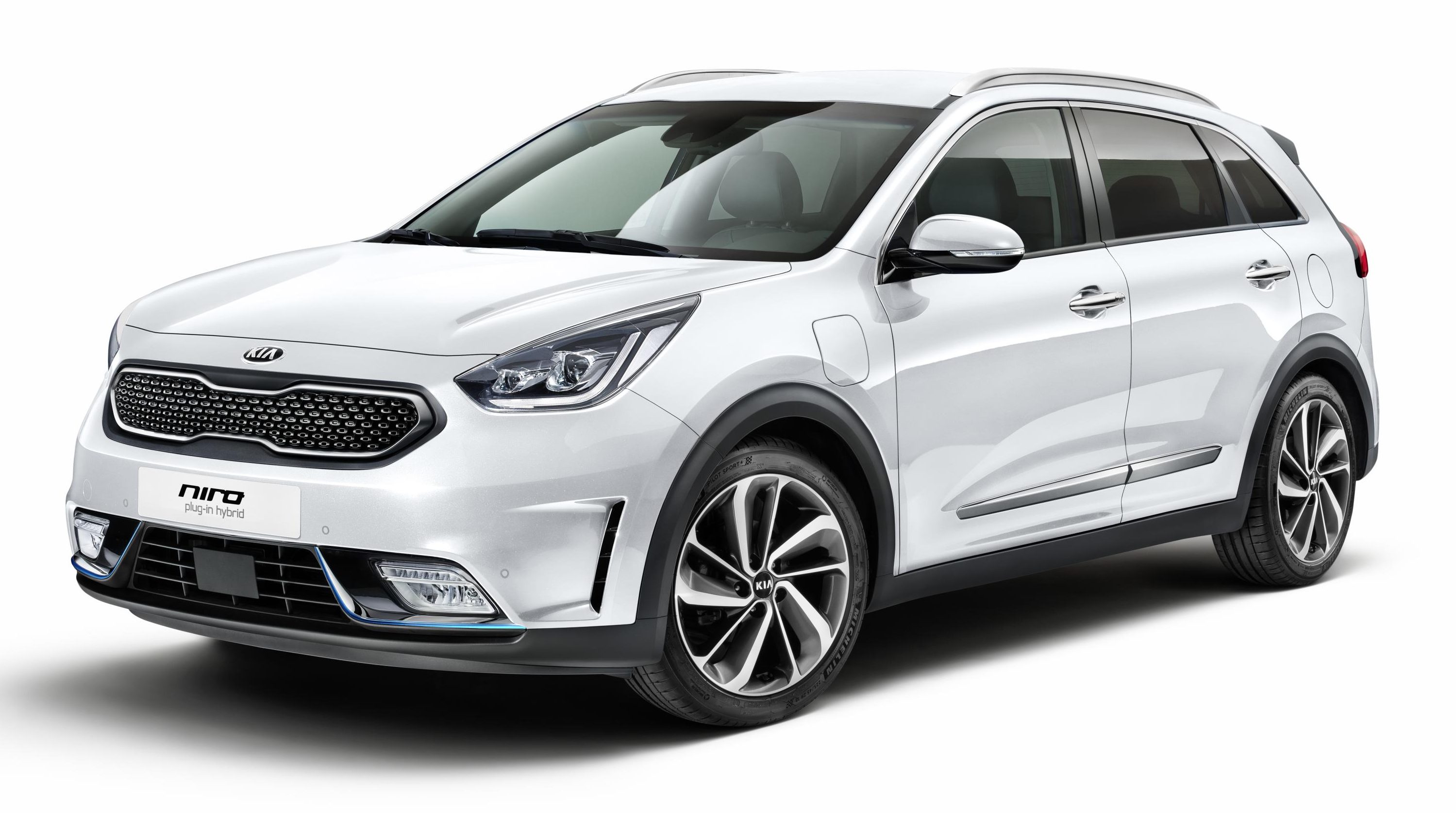
- Niro Plug-in Hybrid model on sale across Europe during Q3 2017
- 8.9 kWh High-capacity lithium-polymer battery pack and 1.6-litre GDI engine
- Development engineers target pure-electric range over 55 kilometres
- CO2 emissions targeted to fall below 30 g/km
- Plug-in Hybrid crossover offers 324-litre cargo space and spacious cabin
- Advanced energy-saving measures and unique styling features
- Optional Towing Pack with 1,300 kg capacity
Kia Motors has today unveiled the Niro Plug-in Hybrid at the Geneva International Motor Show. The new derivative combines high versatility and crossover design appeal with maximum fuel efficiency from its advanced new plug-in hybrid powertrain.
The Niro Plug-in Hybrid will go on sale across Europe during Q3 2017, pairing an economical 1.6-litre GDI (gasoline direct injection) engine with a 8.9kWh high-capacity lithium-polymer battery pack. The latest addition to Kia’s hybrid crossover range substantially reduces emissions over the more conventional Niro hybrid – engineers are targeting CO2 emissions below 30 g/km (combined, New European Driving Cycle) and a zero-emissions pure-electric driving range of over 55 kilometres. Final electric range and CO2 emissions figures will be published closer to the car’s on-sale date.
Michael Cole, Chief Operating Officer, Kia Motors Europe, commented: “Annual sales of plug-in hybrid models in Europe are expected to grow to more than 600,000 units by the end of 2023, while the crossover market is also forecast to expand in the coming years. There is a clear demand from customers for a vehicle which combines the practicality and ‘cool’ image of a compact crossover with the ultra-low emissions of an advanced plug-in powertrain. The Niro Plug-in Hybrid will be the only car on the market to offer this combination.”
“The Niro Plug-in Hybrid is one of the latest low-emissions cars from Kia which will help the company achieve its global target for 2020 – to improve fuel efficiency by 25% compared with 2014 levels.”
The Niro Plug-in Hybrid is one of two low-emissions vehicles unveiled by Kia at the Geneva International Motor Show, alongside the new Optima Sportswagon Plug-in Hybrid.
Engineers targeting 55-kilometre plus pure-electric range and sub 30 g/km CO2
The Niro Plug-in Hybrid offers buyers a convincing alternative to compact crossovers powered by traditional gasoline or diesel internal combustion engines. The car gives owners the opportunity to complete short journeys and daily commutes with zero emissions and lower running costs.
At the heart of the Niro’s new plug-in powertrain is a high-capacity 8.9 kWh lithium-polymer battery pack, growing in size from the 1.56 kWh battery pack found in Kia’s hybrid crossover. The new battery pack is paired with a more powerful 44.5 kW electric motor (offering almost 40% more power, up from 32 kW) compared to the Hybrid model.
The battery and electric motor are paired with the Niro’s efficient 1.6-litre ‘Kappa’ four-cylinder GDI engine, which independently produces 105 ps and 147 Nm torque. The total power and torque output for the Niro Plug-in Hybrid’s powertrain will be 141 ps and 265 Nm, enabling the new model to accelerate from 0-to-100 kph in 10.8 seconds (0.7 seconds quicker than the standard Niro).
With greater capacity and electric power output, Kia engineers are targeting a pure-electric driving range of over 55 km. While the standard Niro hybrid emits just 88 g/km of CO2 in its most efficient configuration, emissions for the Plug-in Hybrid model will drop significantly, to below 30 g/km (combined, New European Driving Cycle).
Power is applied to the road through the Niro’s six-speed double-clutch transmission (6DCT), allowing drivers to shift gear for themselves for a more immediate, more entertaining drive than other hybrid models equipped with a traditional electronic continuously-variable transmission (e-CVT). The 6DCT is paired with a Transmission-Mounted Electric Device (TMED), which allows the full output of both the engine and electric motor to be transferred in parallel through the transmission, with a minimal loss of energy. This differs from the power-split systems typical of an e-CVT hybrid, which converts a portion of engine output for delivery through the electric motor, resulting in power losses from energy conversion.
Energy-harvesting and predictive driving assistant technologies
The Niro Plug-in Hybrid provides owners with a range of technologies to enhance battery efficiency and improve the car’s range – in zero-emissions electric mode, and when the 1.6-litre engine is in use.
Regenerative braking technology allows the Niro to harvest kinetic energy and recharge the battery pack while coasting or braking, while a new Eco Driving Assistant System (Eco DAS) provides drivers with intelligent guidance on how to drive more efficiently under current conditions. Eco DAS includes Coasting Guide Control (CGC) and Predictive Energy Control (PEC), enabling drivers to maximise fuel mileage by suggesting when to coast or brake.
CGC alerts drivers as to the best time to lift off the accelerator and coast towards a junction, allowing the battery to regenerate under engine deceleration. Operating at certain speeds when a navigation destination is set, it alerts drivers when to coast via a small icon in the instrument cluster as well as an unobtrusive audible warning.
PEC uses the navigation and cruise control systems to anticipate topographical changes – inclines and bends – in the route ahead. It uses this information to determine when best to recharge the battery pack, or to direct stored energy to the wheels and actively manage energy flow accordingly. For example, if it detects an uphill incline coming up, the system may choose to retain more electrical energy to provide greater battery assistance climbing the hill. Conversely, if PEC detects an upcoming opportunity to coast downhill, it may choose to discharge some electrical energy ahead of time, enhancing short-term engine efficiency in the knowledge that it can recharge soon.
Niro retains crossover versatility with efficient powertrain packaging
The Kia Niro was engineered from the very start to accommodate a specific range of hybrid powertrains. The introduction of a plug-in hybrid powertrain therefore has minimal effect on packaging and versatility.
The Niro Plug-in Hybrid’s high-capacity battery pack is located beneath the floor of the 324 litre (VDA) boot and beneath the rear seat bench. This allows the new derivative to offer buyers greater practicality than other C-segment plug-in hybrid hatchback models, while space in the cabin of the Niro remains unaffected.
There is a dedicated space beneath the boot floor to store the Niro Plug-in Hybrid’s charging cable when not in use.
The Niro Plug-in Hybrid will follow its Hybrid sibling in offering an optional Towing Pack – rare amongst cars in the hybrid class – allowing owners to tow braked loads of up to 1,300 kg.
Plug-in Hybrid design and in-car safety and convenience technologies
The exterior and interior design of the Kia Niro Plug-in Hybrid has been adapted to differentiate the car from the existing Niro hybrid.
On the outside of the car, the Niro Plug-in Hybrid features a new satin chrome grille surround, as well as special chrome brightwork with a clean metallic-blue finish, applied to thin ‘blades’ in the front and rear bumpers. The Plug-in Hybrid model is available with 16-inch alloy wheels, engineered to reduce wind resistance, as well as new full-LED headlamps and dedicated ‘Eco Plug-in’ badging.
The interior of the Niro Plug-in Hybrid is upholstered in single-tone black leather, or two-tone light grey and black leather, finished with blue stitching, as well as a new blue surround for the dashboard air vents. The new derivative features a new 7.0-inch full-TFT driver instrument cluster, displayingkey information about the powertrain – such as the battery’s state of charge – as well as offering suggestions for a more efficient driving style.
The dashboard is fitted with Kia’s latest 8.0-inch touchscreen infotainment and navigation system, configured for the Plug-in Hybrid model to display current electric-only range and the location of nearby charging stations. The infotainment system provides owners with maximum smartphone integration, offering Android Auto™ and Apple CarPlay™. Kia Connected Services powered by TomTomTM provides live traffic updates, weather forecasts and, in certain markets, speed camera alerts. The new Plug-in Hybrid model continues to offer buyers the Niro’s wireless smartphone charger, letting users charge their mobile devices on the move. A powerful JBL® premium sound system is also available, with Clari-Fi technology to restore the original sound of music that may be lost during the digital audio compression process.
The Niro Plug-in Hybrid offers buyers the same varied range of active safety technologies designed to avoid or mitigate the effects of a collision. As standard, the car is equipped with Kia Vehicle Stability Management (VSM) for maximum stability under braking and cornering. If VSM detects a loss of traction, it uses the car’s Electronic Stability Control (ESC) system and the electric motor-driven power steering to help the driver retain control. Other standard active hazard-avoidance technologies available to Niro Plug-in Hybrid buyers include, Autonomous Emergency Braking* (Forward Collision-Avoidance Assist), Lane Keeping Assist, and Driver Attention Warning. Optional safety technologies include Smart Cruise Control, Blind-Spot Collision Warning and Rear Cross-Traffic Collision Warning.
2017 Kia Niro Plug-in Hybrid on-sale during Q3 2017
The new Kia Niro Plug-in Hybrid will go on sale across Europe during Q3 2017 and is manufactured for European markets at Kia’s plant in Hwasung, Korea. The car is sold as standard with Kia’s unique 7-Year, 100,000m warranty, which also covers the battery pack.
*The Autonomous Emergency Braking System (AEBS, Forward Collision-Avoidance Assist) is an assistance system and does not relieve the driver from his/her responsibility to safely operate the vehicle at any time. The driver still has to adapt his/her driving behaviour to his/her personal driving capabilities, to the legal requirements and to the overall road and traffic conditions. AEBS is not designed to drive the vehicle autonomously. For further information, please refer to the owner’s manual.
KIA NIRO PLUG-IN HYBRID – TECHNICAL SPECIFICATIONS (EUROPE)
Body and chassis
Five-door, five-seater plug-in hybrid crossover, with steel and aluminium unitary construction bodyshell. Gasoline four-cylinder engine and parallel plug-in hybrid system driving the front wheels via six-speed double-clutch transmission.
Engines
1.6-litre / 105 ps GDI
Type DOHC, four cylinder in-line
Capacity 1.6-litres
Bore and stroke 72.0 x 97.0
Compression ratio 13.0:1
Max power 105 ps (77 kW) @ 5,700 rpm
Max torque 147 Nm (108 lb ft) @ 4,000 rpm
Valves 16 (four per cylinder)
Fuel system Gasoline direct injection
Emissions class Euro Stage 6b
Battery and electric motor
Battery type Lithium-ion polymer
Voltage 360 V
Energy 8.9 kWh
Max power (motor) 60.5 ps (44.5 kW)
Max torque 170 Nm (125.4lb ft)
Combined hybrid system
Total power 141 ps (139 hp)
Total torque 265Nm (195lb ft)
Transmission
Six-speed double-clutch transmission (DCT)
Gear ratios
1 3.867
2 2.217
3 1.371
4 0.93
5 0.956
6 0.767
Reverse 5.351
Final drive 4.438(1st/2nd/ 3rd/4th) / 3.227 (5th/6th/Rvs)
Drivetrain
Front-wheel drive
Suspension and damping
Front Fully-independent by subframe-mounted MacPherson struts, coil springs and gas-filled shock absorbers, with anti-roll stabiliser bar
Rear Fully-independent by subframe-mounted double wishbones, coil springs and gas-filled shock absorbers, with anti-roll stabiliser bar
Steering
Type Electric motor-driven rack-and-pinion power steering
Steering ratio 13.9:1
Turns, lock-to-lock 2.66
Turning circle 5.3 metres
Brakes
Front 15-inch ventilated discs
Rear 15-inch solid discs
Parking brake Foot-operated
Wheels and tyres
Standard Alloy 16-inch, 205/60 R16 tyres
Dimensions (mm)
Exterior
Overall length 4,355 Overall width* 1,805
Overall height 1,535 Wheelbase 2,700
Front overhang 870 Rear overhang 785
Minimum ground clearance 160
*excluding door mirrors
Interior
1st row 2nd row
Head room 1,018 993
Leg room 1,059 950
Shoulder room 1,423 1,402
Hip room 1,364 1,228
Capacities
Fuel tank 43 litres
Luggage (VDA) 324 litres
Weights (kg)
Curb weight 1,519
Gross weight 2,000
Tow capacity, braked 1,300*
*Optional Towing Pack
Performance
Top speed (kph) 172
0-100 kph (secs) 10.8
Economy
CO2 (g/km) <30*
*development target
MARCH 2017





You must be logged in to post a comment.